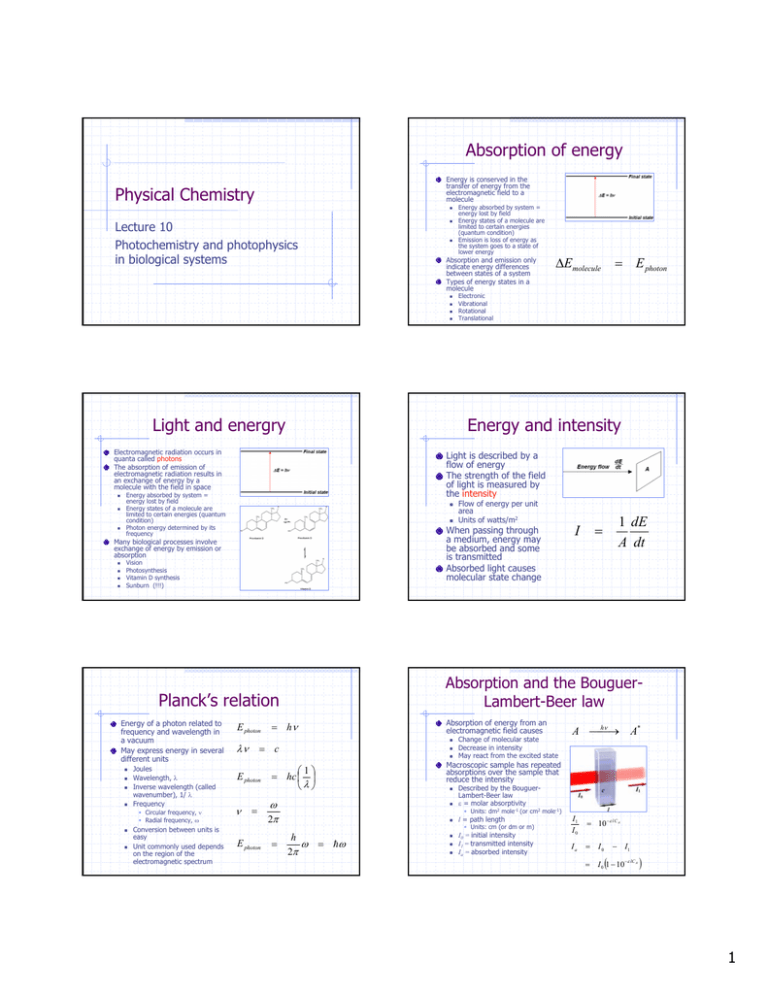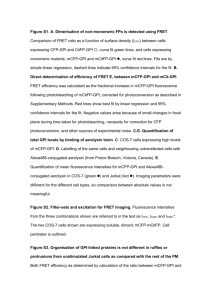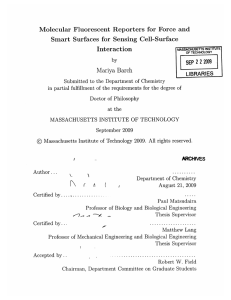Physical Chemistry Light and energry
advertisement

Absorption of energy Energy is conserved in the transfer of energy from the electromagnetic field to a molecule Physical Chemistry Lecture 10 Photochemistry and photophysics in biological systems Absorption and emission only indicate energy differences between states of a system Types of energy states in a molecule Light and energry Energy absorbed by system = energy lost by field Energy states of a molecule are limited to certain energies (quantum condition) Photon energy determined by its frequency Joules Wavelength, Inverse wavelength (called wavenumber), 1/ Frequency Circular frequency, Radial frequency, Conversion between units is easy Unit commonly used depends on the region of the electromagnetic spectrum Flow of energy per unit area Units of watts/m2 E photon Absorption of energy from an electromagnetic field causes h c E photon E photon 1 dE A dt Change of molecular state Decrease in intensity May react from the excited state h A A* Macroscopic sample has repeated absorptions over the sample that reduce the intensity 1 hc Described by the BouguerLambert-Beer law = molar absorptivity l = path length Units: dm2 mole-1 (or cm2 mole-1) 2 I Absorption and the BouguerLambert-Beer law Planck’s relation Electronic Vibrational Rotational Translational When passing through a medium, energy may be absorbed and some is transmitted Absorbed light causes molecular state change Vision Photosynthesis Vitamin D synthesis Sunburn (!!!) Energy of a photon related to frequency and wavelength in a vacuum May express energy in several different units E photon Light is described by a flow of energy The strength of the field of light is measured by the intensity Many biological processes involve exchange of energy by emission or absorption Emolecule Energy and intensity Electromagnetic radiation occurs in quanta called photons The absorption of emission of electromagnetic radiation results in an exchange of energy by a molecule with the field in space Energy absorbed by system = energy lost by field Energy states of a molecule are limited to certain energies (quantum condition) Emission is loss of energy as the system goes to a state of lower energy Units: cm (or dm or m) h 2 I0 = initial intensity I1 = transmitted intensity Ia = absorbed intensity I1 I0 Ia 10 l C A I0 I1 I 0 1 10 lC A 1 Energetics after absorption Steady-state effects The absorption of energy from an electromagnetic field may be followed by additional processes Constant irradiation leads to a steady state concentration of the first excited singlet Fluorescence Internal conversion Vibrational relaxation Intersystem crossing Phosphorescence All processes involve the redistribution of energy Emission Transfer to other modes Concentration depends on the absorption rate constant and the fluorescence lifetime Fluorescence intensity depends on [S1] Defines Photochemical steps The molecule may react upon excitation The rate depends on how many molecules absorb light Proportional to the absorbed intensity For weak absorption, rate is directly proportional to 1000 I a l 1000 I 0 1 10 lC A l 1000 I 0 1 e (ln10)lC A l 1000(ln 10)I 0C A Concentration Initial intensity First order equation Loss of reactant is first order “Rate constant” contains molar absorptivity and light intensity C A (0)e 1000 (ln10 )I 0t C A (t ) Elementary photoprocesses affecting the S1 state; quenching Many ways for molecules to lose energy Radiative decay Intersystem crossing Internal conversion Can also exchange energy by interaction with a mediator (called a quencher) that removes energy Think of this as changing the “lifetime” of the excited state Lifetime depends on the concentration of the quencher S0 ka h S1 S1 f S0 k S `1 k isc T1 S1 k ic S0 S1 Q Q S0 k h k f k a f [ S 0 ]ss k f [ S1 ]ss f ka [S0 ] f A I 0 f k f f kf k f kic kisc kQ [Q] 1 1 I f , 0 kQ kf [Q] Example: Stern-Volmer plots for quenching of Zn cytochrome-c fluorescence by acrylamide with (a) nothing added; (b) Apaf-1 added; and (c) Apaf-1 and dATP added From Purring-Koch and McLendon, PNAS, 97, 11928 (2000). Transient S1 concentration is created by exposure to a short light pulse Q 1 k f kisc kic kQ [Q ] 1 If Optical perturbation to determine lifetimes d [ S1 ] k a [ S 0 ] k f kisc kic kQ [Q ][ S1 ] dt f If k a f [ S 0 ]ss Quantum yield Absorption cross-section Steady-state fluorescence intensity depends on the lifetime With a quencher present, one can isolate the effects on fluorescence by monitoring it as a function of the quencher concentration A P dC A dt f [ S1 ]ss Stern-Volmer plots h d [ S1 ] 0 dt 1 k a [ S 0 ]ss [ S1 ]ss Fluorescence builds rapidly during the pulse Concentration dissipates by various processes characterized by the lifetime Fluorescence intensity after the pulse is timedependent Often exponential decay Analysis is complex due to finite excitation Determines the lifetime t I (t ) I (0) exp f 2 FRET Kinetics of electron transfer Fluorescent quenching occurs in many ways Oxidation and reduction are majors processes in chemistry Transfer within molecule Transfer outside of molecule Fluorescent resonant energy transfer (FRET) involves interaction with another molecule to form a complex Mechanism h D* D Excitation Intersystem crossing Resonant energy transfer to another molecule, the acceptor (A) Acceptor fluorescence * D D* k isc D D D* Detected by change in quantum yield kf fret A D k kf ' * A * A A* FRET Photosynthesis D Excitation of donor (D) Intersystem crossing Resonant energy transfer to another molecule, the acceptor (A) Acceptor fluorescence Changes quantum yield Förster theory shows strong dependence of efficiency of transfer on the donoracceptor distance in the complex Common process involving electron transfer Kinetics of electron transfer Mechanism Involve transfer of electrons D* 0 Can be used to measure distances Distances need to be roughly of molecular dimensions D h D* D* f D D* k isc D k fret A D k f k ' A* fret A* A* kf k f kisc kf k f kisc k fret Eff 1 fret 0 r06 r06 r 6 Mechanism of transfer involves formation of a donor-acceptor complex Both the donor-acceptor complex and the charge-transfer complex are intermediates The rate constant for transfer depends on all of the possible rate constants of the elementary steps kd DA kd ' DA D A k et DA D A b et D A k DA sep D A D k d [ DA] 0 dt A d [ D A ] 0 dt v k sep [ D A ] k sep ket k d [ D ][ A] k sep ket k d ' kb et k d ' Marcus theory of electron transfer FRET FRET allows one to see different structures because of contrast provided by different quenching rates Separate structure form complexes differently, giving different FRET emission Example: alpha-synuclein antibody labeled with fluorescein forming complexes with HSP-3 A The rate constant for electron transfer depends on a number of factors k e r e G / RT Structure of the complex (r) Energy differences between states Free energy Reorganization energy Free energy of activation depends on both Image by Brian J. Bacskai, Massachusetts General Hospital Rate goes through a maximum Experimentally demonstrated for biphenyl and a variety of acceptors 3 Summary Absorption of energy in the form of photons plays a fundamental part in biological processes Redistribution of energy Change of structure Reaction Oxidation-reduction is a fundamental process in biological systems Occurs in many reactions Kinetics of steps important 4







